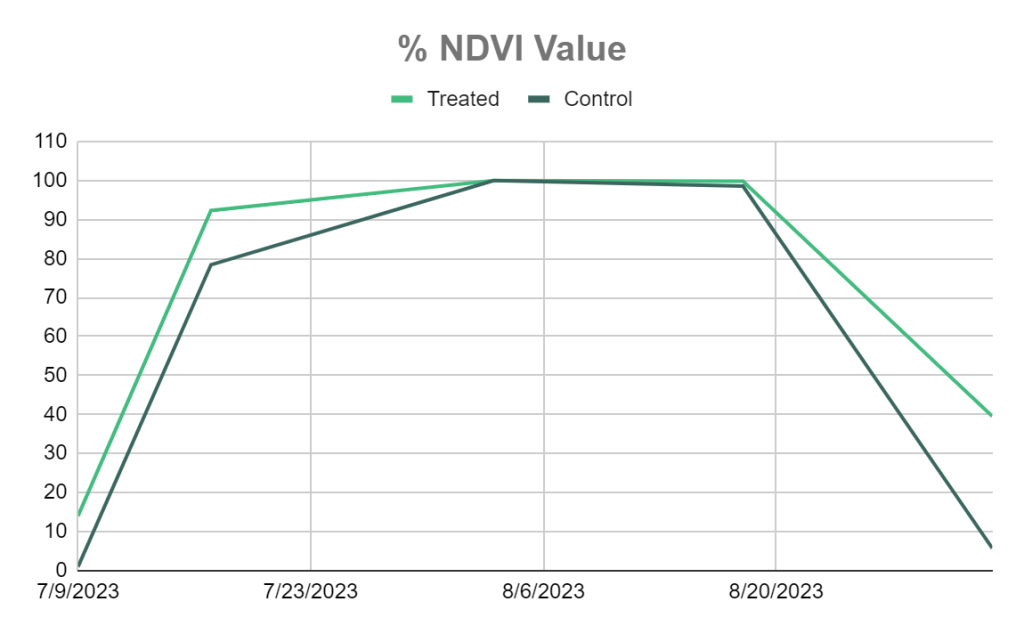Location: Kanorado, KS
Challenge
- Limited water availability limits yield potential.
Farm Goals
- Reduce chemical and water inputs; increase corn yield
Trial Setup
- A split-field design was used to compare TerraFlow®-treated corn and untreated corn for agronomic performance. Control and treatment acres had similar topography and soil types.
- Fertilizer rates, seed variety, planting populations and dates, irrigation rates and harvest dates remained consistent between control and treatment fields.
- Soil moisture sensors were installed at various depths within the profile to compare moisture availability in the control and treated sides of the field. These readings were collected every hour and condensed into monthly totals.
- Industry-standard scouting techniques were implemented throughout the season to monitor early crop development.
- Control and treated areas were harvested separately, and scale tickets captured average yields in each representative area.
- A paired T-Test and Least Significant Difference analysis were performed on this data.
Trial Results
The following results were observed in the UpTerra-treated field, relative to the control. These results were achieved despite limited irrigation during peak summer heat in August and September.
- 16.8% yield increase (+15.3 bu/ac)
- $72.06 of additional income per acre
- 18-20% absolute moisture availability increase, representing a 27-29% relative increase in soil moisture over the control
- Stronger root systems, more vigorous plant growth and higher NDVI values throughout the season
Bushels Per Acre16.8% Change |
Income Generation
| Bushels Per Acre | Income Per Acre | |
| Treatment | 106.2 | 500.20 |
| Control | 90.9 | 428.14 |
| Increased Value with UpTerra | 15.3 bu/ac | $72.06/acre |
**Assumption: Corn price of $4.71 per bushel
Soil Moisture Retention
| Available Water (%) | UpTerra Treatment | Control | Absolute Percent Difference | Relative Percentage Change |
| August | 77.89 | 79.49 | -1.60 | -2.01 |
| September | 88.06 | 67.79 | 20.27 | 29.89 |
| October | 86.68 | 68.15 | 18.53 | 27.20 |
Biomass Accumulation
Satellite imagery captured biomass accumulation throughout the season. The treated corn had nearly 15% more biomass during critical reproductive growth stages, potentially improving the plant’s ability to capture light energy for grain fill.

Agronomy Field Assessments
The treatment and control fields were visited throughout the season to observe crop development. The TerraFlow-treated field showed clear agronomic advantages, as shown below. The treatment field’s higher NDVI values validate field observations that TerraFlow provided:
- Greater moisture retention
- Denser root mass
- Improved plant development
| Jul 13, 2023 | Root dig comparisons between treated and control plants Observations:Greater leaf areaIncreased root massMore vigorous growth |
| Aug 24, 2023 | Late-season ear development (approximately 3 weeks before harvest) Observations:Increased ear sizeIncreased kernel counts |
Key Trial Takeaways
- The results indicate that TerraFlow has a positive impact on plant health, corn yield, farm profitability and soil health.
- Based on field scouting, the TerraFlow-treated crop got a stronger start, which had season-long advantages for harnessing more light energy to build yield.
- Improved root health helped the crop extract more moisture and nutrients at critical growth stages, optimizing plant health.
- Better moisture availability in the soil helped reduce plant stress during peak summer heat and dry conditions.
- This trial suggests that TerraFlow can help corn growers achieve higher yields and better water management, improving overall profitability potential.
Related Content
Vegetative Growth in Corn: Simple Tips to Keep Your Crop on Track
Optimizing Corn Irrigation: Tools and Tips for Better Water Management
The True Cost of Farm Irrigation — and How New Technologies Can Help


